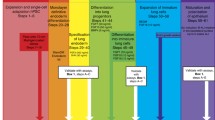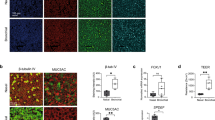Summary
Cystic fibrosis (CF) involves abnormalities in mucus production and secretion of the airway. Studies of the regulation of airway mucin production and secretion has been difficult due to the lack of in vitro models of the airway epithelial cells which express functional differentiation. Because the majority of the mucin in the airway is apparently produced by the submucosal glands, we have focused our attention on the development of cell culture models of human airway submucosal glands. This report describes the propagation of CF airway submucosal gland epithelial cells which continue to express mucin production. The CF bronchus was obtained from a 31-yr-old patient who received a double lung transplant. The glands were dissected out and primary cultures prepared by the explant/outgrowth procedure. The cells were immortalized by infection with Adl2-SV40 hybrid virus. The cultures are maintained in serum-free keratinocyte basal medium supplemented with insulin (5µg/ml), hydrocortisone (0.5µg/ml), epidermal growth factor (10 ng/ml), bovine pituitary extract (25µg/ml), and antibiotics. Cultures were passaged using 0.125% trypsin in Ca+2 and Mg+2-free Hanks’, balanced salt solution. Polymerase chain reaction (PCR) analysis demonstrated that the cells were homozygous for the ΔF508 mutation. Morphologic observations showed that the cells were epithelial and were interconnected by sparsely distributed desmosomes. Their cytoplasm contained secretory-type structures including abundant Golgi, rough endoplasmic reticulum, and secretory vesicles. Immunofluorescent studies determined that all cells were positive for cytokeratins, mucin glycoconjugates, and cystic fibrosis transmembrane conductance regulator. The cultures secreted substantial amounts of mucin glycoproteins and expressed the MUC-2 mucin gene. Patch clamp experiments revealed that the cells expressed defective Cl− channels which were not activated by Forskolin.
Similar content being viewed by others
References
Anderson, M. P.; Gregory, R. J.; Thompson, S., et al. Demonstration that CFTR is a chloride channel by alteration of its anion selectivity. Science 253:202–205; 1991.
Aviv, H.; Leder, P. Purification of biologically active globin messenger RNA by an oligothymidylic acid cellulose. Proc. Natl. Acad. Sci. USA 69:1408–1412; 1972.
Ballabio, A.; Gibbs, R. A.; Caskly, C. T. PCR test for cystic fibrosis deletion. Nature 343:220; 1990.
Basbaum, C. B.; Finkbeiner, W. E. Airway secretions: a cell specific analysis. Horm. Metab. Res. 20:661–667; 1988.
Berschneider, H. M.; Knowles, M. R.; Azizkhan, R. G., et al. Altered intestinal chloride transport in cystic fibrosis. FASEB J. 2:2625–2629; 1988.
Bradbury, N. A.; Jilling, T.; Berta, G., et al. Regulation of plasma membrane recycling by CFTR. Science 256:530–532; 1992.
Cheng, S. H.; Gregory, R. J.; Marshall, J., et al. Defective intracellular transport and processing of CFTR is the molecular basis of most cystic fibrosis. Cell 63:827–834; 1990.
Chomczynski, P.; Sacchi, N. Single-step method of RNA isolation by acid guanidinium thiocyanate-phenol-chloroform extraction. Anal. Biochem. 162:156–159; 1987.
Chopra, D. P.; Shoemaker, R. L.; Taylor, G. W., et al. Characterization of epithelial cell cultures derived from human tracheal glands. In Vitro Cell. Dev. Biol. 27:13–20; 1991.
Chopra, D. P.; Taylor, G. W.; Mathieu, P. A., et al. Immortalization of human tracheal gland epithelial cells by adenovirus 12-SV40 hybrid virus. In Vitro Cell. Dev. Biol. 27A:763–765; 1991.
Christian, B. J.; Loretz, L. J.; Oberley, T. D., et al. Characterization of human uroepithelial cells immortalizedin vitro by simian virus 40. Cancer Res. 47:6066–6073; 1987.
Collins, F. S. Cystic fibrosis: molecular biology and therapeutic implications. Science 256:774–779; 1992.
Cozens, A. L.; Yezzi, M. J.; Chin, L., et al. Characterization of immortal cystic fibrosis tracheobronchial gland epithelial cells. Proc. Natl. Acad. Sci. USA 89:5171–5175; 1992.
Dovey, M.; Wisseman, C. L.; Roggli, V. L., et al. Ultrastructural morphology of the lung in cystic fibrosis. J. Submicrosc. Cytol. Pathol. 21:521–534; 1989.
Frizzell, R. A.; Rechkemmer, G.; Shoemaker, R. L. Altered regulation of airway epithelial cell chloride channels in cystic fibrosis. Science 233:558–560; 1986.
Gasser, K. W.; DiDomenico, J.; Hopfer, U. Secretagogues activate chloride transport pathways in pancreatic zymogen granules. Am. J. Physiol. 254:G93–99; 1988.
Gregory, R. J.; Rich, D. P.; Cheng, S. H., et al. Maturation and function of cystic fibrosis transmembrane conductance regulator variants bearing mutations in putative nucleotide-binding domains 1 and 2. Mol. Cell. Biol. 11:3886–3893; 1991.
Gum, J. R.; Byrd, J. C.; Hicks, J. W., et al. Molecular cloning of human intestinal mucin cDNA’s: sequence analysis and evidence for genetic polymorphism. J. Biol. Chem. 264:6480–6487; 1989.
Gum, J. R.; Hicks, J. W.; Swallow, D. M., et al. Molecular cloning of cDNAs derived from a novel human intestinal mucin gene. Biochem. Biophys. Res. Comm. 171:407–415; 1990.
Hamill, O. P.; Marty, A.; Neher, E., et al. Improved patch-clamp techniques for high resolution current recording from cells and cell-free membrane patches. Pflugers Arch. Eur. J. Physiol. 391:85–100; 1981.
Jefferson, D. M.; Valentich, J. D.; Marini, F. C., et al. Expression of normal and cystic fibrosis phenotypes by continuous airway epithelial cell lines. Am. J. Physiol. 259:L496-L505; 1990.
Jetten, A. M.; Yankaskas, J. R.; Stutts, M. J., et al. Persistence of abnormal chloride conductance regulation in transformed cystic fibrosis epithelia. Science 244:1472–1475; 1989.
Johnson, J. P.; Louie, E.; Lewiston, N. J., et al.β-Adrenergic sweat responses in cystic fibrosis heterozygotes with and without the ΔF508 allele. Pediatr. Res. 29:525–528; 1991.
Kartner, N.; Hanrahan, J. W.; Jensen, T. J., et al. Expression of the cystic fibrosis gene in non-epithelial invertebrate cells produces a regulated anion conductance. Cell 64:681–691; 1991.
Kerem, B.-S.; Rommens, J. M.; Buchanan, J. A., et al. Identification of the cystic fibrosis gene: genetic analysis. Science 245:1073–1080; 1989.
Knowles, M.; Gatzy, J.; Boucher, R. Relative ion permeability of normal and cystic fibrosis nasal epithelium. J. Clin. Invest. 71:1410–1417; 1983.
Maniatis, T.; Fritsch, E. F.; Sambrook, J. Molecular cloning: a laboratory manual. Cold Spring Harbor, New York: Cold Spring Harbor Laboratories; 1982.
Melber, K.; Zhu, G.; Diamond, L. SV40-transformed human melanocyte sensitivity to growth inhibition by the phorbal ester 12-O-tetradecanoylphorboal-13-acetate. Cancer Res. 49:3650–3655; 1989.
Pollard, H. B.; Pazoles, C. J.; Creutz, C. E., et al. An osmotic mechanism for exocytosis from disassociated Chromaffin cells. J. Biol. Chem. 259:1114–1121; 1984.
Quinton, P. M. Chloride impermeability in cystic fibrosis. Nature 301:421–422; 1983.
Rae, J. L.; Cooper, K. New techniques for the study of lens electrophysiology. Exp. Eye Res. 50:603–614; 1990.
Riordan, J. R.; Rommens, J. M.; Kerem, B.-S., et al. Identification of the cystic fibrosis gene: cloning and characterization of complementary DNA. Science 245:1066–1073; 1989.
Rommens, J. M.; Iannuzzi, M. C.; Kerem, B.-S.; et al. Identification of the cystic fibrosis gene: chromosome walking and jumping. Science 245:1059–1065; 1989.
Sack, G. H., Jr. Human cell transformation by simian virus 40: a review. In Vitro 17:1–19; 1981.
Sato, K.; Sato, F. Defective beta adrenergic response of cystic fibrosis sweat glandsin vivo andin vitro. J. Clin. Invest. 73:1763–1771; 1984.
Scholte, B. J.; Kansen, M.; Hoogeveen, A. T., et al. Immortalization of nasal polyp epithelial cells from cystic fibrosis patients. Exp. Cell. Res. 182:559–571; 1989.
Sturgess, J. M.; Imrie, J. Quantitative evaluation of the development of the tracheal submucosal glands in infants with cystic fibrosis and control infants. Am. J. Pathol. 106:303–311; 1982.
Taylor, C. J.; Baxter, P. S.; Hardcastle, J., et al. Failure to induce secretion in jejunal biopsies from children with cystic fibrosis. Gut 29:957–962; 1988.
Taylor, G. W.; Chopra, D. P. Adrenergic and cholinergic stimulation of human transformed tracheal gland epithelial cellsin vitro. Toxicologist 11:226; 1991.
Taylor G. W.; Chopra, D. P.; Mathieu, P. A. Differences in secretory profiles of epithelial cell cultures derived from human tracheal, bronchial and submucosal glands. Epith. Cell Biol. 2:163–169; 1993.
Taylor-Papadimitriou, J.; Purkis, P.; Lane, E. B., et al. Effects of SV40 transformation on the cytoskeleton and behavioral properties of human keratinocytes. Cell Differ. 11:169–180; 1982.
Welsh, M. J.; Liedtke, C. M. Chloride and potassium channels in cystic fibrosis airway epithelium. Nature 322:467–470; 1986.
Zeitlin, P. L.; Lu, L.; Rhim, J., et al. A cystic fibrosis bronchial cell line: immortalization by Adeno-12-SV40 infection. Am. J. Respir. Cell. Mol. Biol. 4:313–319; 1991.
Author information
Authors and Affiliations
Rights and permissions
About this article
Cite this article
Chora, D.P., Reddy, L., Gupta, S.K. et al. Differentiation of immortalized epithelial cells derived from cystic fibrosis airway submucosal glands. In Vitro Cell Dev Biol - Animal 30, 539–546 (1994). https://doi.org/10.1007/BF02631327
Received:
Accepted:
Issue Date:
DOI: https://doi.org/10.1007/BF02631327




